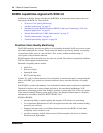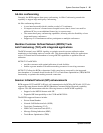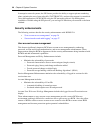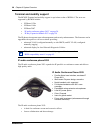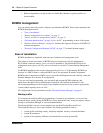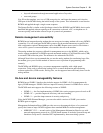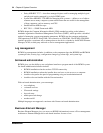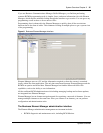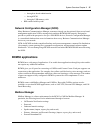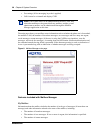
32 Chapter 2 System Overview
NN40020-200NN40020-200
• Reduced dependency on dip switches for Media Bay Modules as global profiles are
downloadable
BCM50 management
You can quickly and easily install, configure, and administer BCM50. These topics summarize the
BCM50 management areas:
• "Ease of installation"
• “Remote management accessibility” on page 33
• “On-box and device manageability features” on page 33
• “Set-based administration” on page 34, for “no-PC” programming of most of the system
• “Business Element Manager” on page 34, interface that supports all aspects of BCM50 2.0
element management
• “Network Configuration Manager (NCM)” on page 37, for multi-element support
Ease of installation
BCM50 installation is simplified with innovative hardware and management tools.
The simple rack-and-stack nature of BCM50 physical installation, with the multipurpose
RJ-45-based connector strategy, gives you ease of installation. The dedicated RJ-45 port for
management access gives you easy access to the unit for on-site PC-based element management
tasks.
For BCM50 installations that require data networking, IP sets, or VoIP trunking, BCM50 can
function as a DHCP client to a network DHCP server for automated IP address assignment.
BCM50 can also function as a DHCP server to provide both IP phone sets and a directly connected
Element Manager PC with their IP configuration.
If you use set-based programming, you can install and program BCM50 telephony and
applications through set-based administration. Installers who familiarize themselves with
set-based programming use the keypad of any telephone connected to the system to program the
system without requiring access to a PC.
All configuration can be performed using the “Business Element Manager” on page 34.
Startup profile
To accelerate the initial installation programming of system-level parameters, you can use the
Startup Profile to quickly bring the BCM50 to a basic operational state, ready to program, without
having to use Element Manager or set-based administration.
The Startup Profile is an easy-to-use template you can datafill using Microsoft Excel.
The Startup Profile gives you a quick interface for defining parameters such as:
• system profile including country, telephony template, and key voicemail attributes
• system IP parameters
• system-level telephony attributes to automatically create the system DNs



